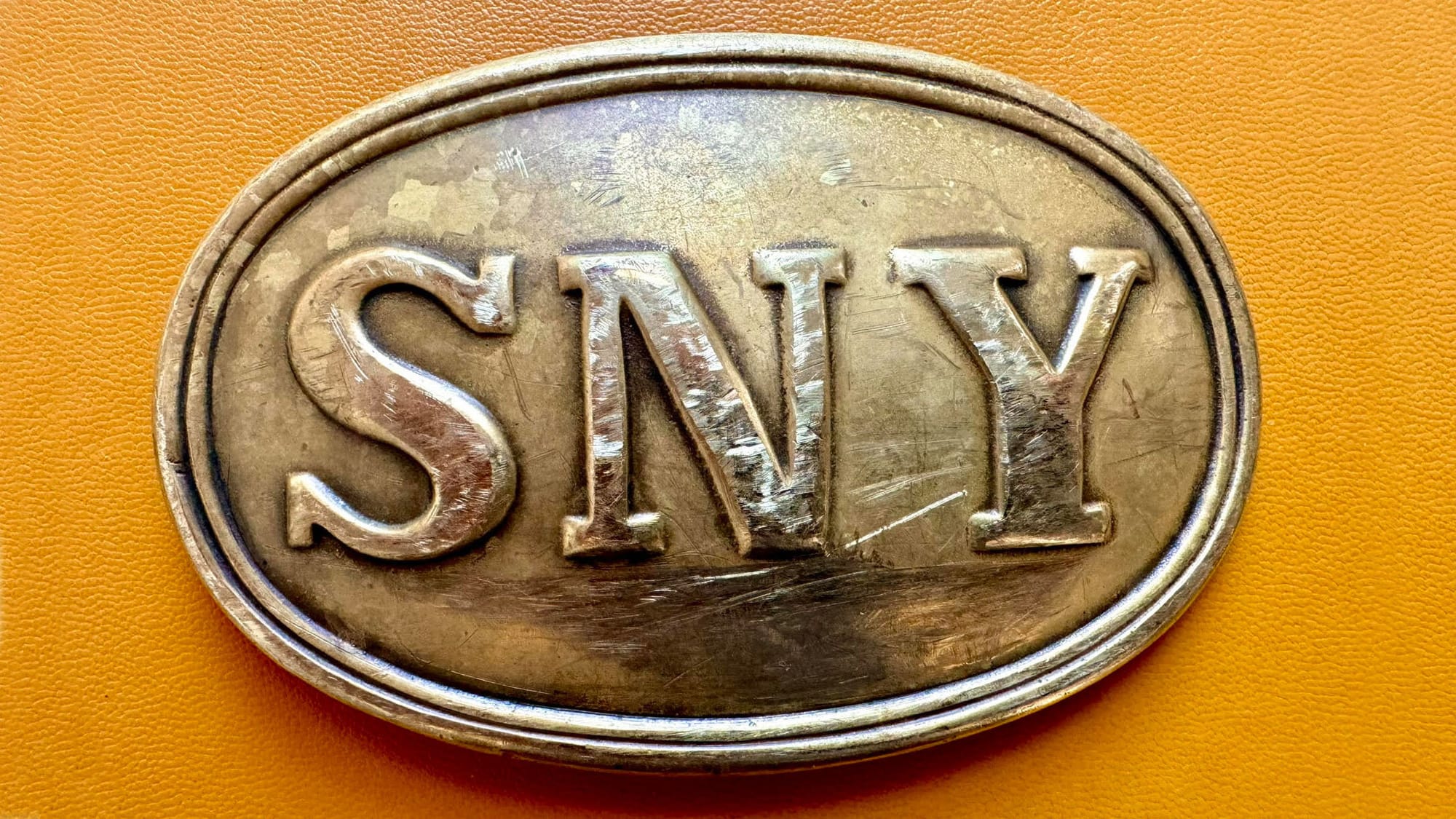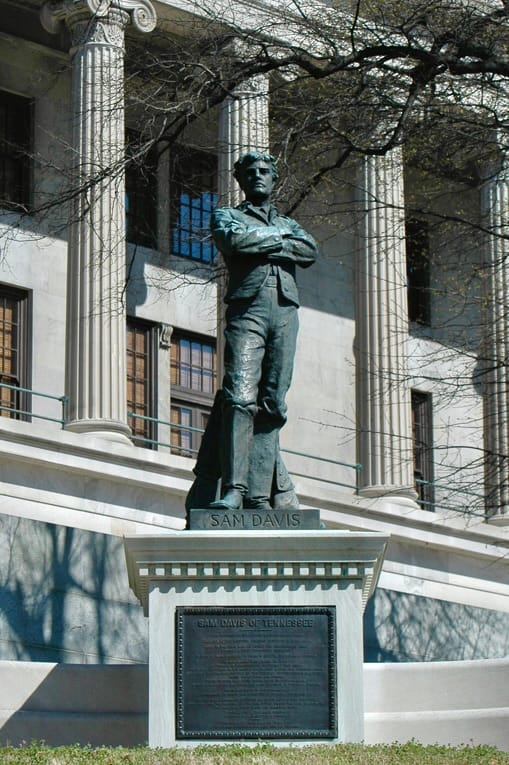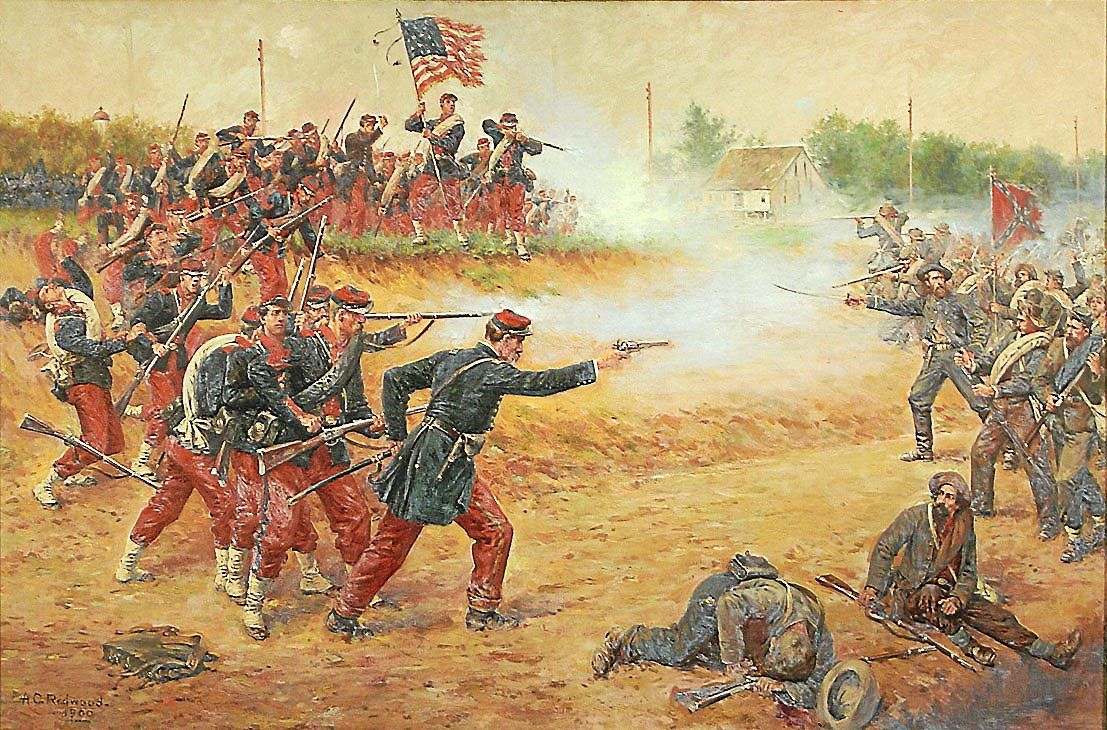Belt Buckle

by Gabriel Snyder
Ah! I am very glad you asked me about my belt buckle. When I was growing up in the South, I kind of always had an obsession with big leather belts with the showy Honky Tonk buckles. They were a little glamorous, as well as a little menacing–especially to anyone who as a child had found themselves on the business end of that leather strap, as I had. But I never got one until someone gave me a leather belt, but no buckle, in early 2017, just after the Trump election.
I had a visit back home to Nashville scheduled that spring. “Oh!” I thought. “That will be the perfect place to find one.” But when I got to the thrift shops, I found only belt buckles with Confederate flags or names of trucking companies I’d never heard of on them. Neither theme resonated with me, so I returned to Brooklyn empty-handed.
The self-flagellating takes were still pouring in about how the coastal elites had lost touch with the white supremacists of the South, and we needed to listen to them more and understand that our repugnance to their racism was, in fact, a new form of bigotry dividing the nation. I was pretty upset, as many of us were. It started me thinking that when I was growing up in Nashville, the Civil War felt like living history. As a small boy, I lived for a time in a farmhouse that had served as a field hospital during the Civil War. I found out much later that there was even a ghost story attached to it, which didn’t surprise me much because I remember seeing old blood stains still on the wood floors. (The farmhouse and its corresponding plantation mansion and the rotting slave quarters standing in the woods between them were torn down to make way for a Kroger’s.)
The way this story goes, the farmhouse was first used as a Confederate hospital. However, as the Union advanced in the Battle of Nashville and the frontlines changed, it was captured by Union troops, who proceeded to turn it into their own hospital. A Confederate nurse who had stayed behind with the wounded who couldn’t retreat was captured, too, and — in a grave act of dishonor — was forced to wear a ball and chain and to tend to the Union wounded. So if you were to go into your bathroom at midnight, and say into the mirror three times:
I don’t believe in the Breeze Hill Witch
I don’t believe in the Breeze Hill Witch
I don’t believe in the Breeze Hill Witch
The nurse’s ghost, still aggrieved over her ignominy, would appear and cackle at you. This theory was put to the test in middle school, and while we did not encounter the Breeze Hill Witch, the ghosts of the Civil War were all around us, nonetheless.
Every year in grade school, we’d be trundled off to some historical preserve to learn about the Civil War battles that had happened locally. The city’s preeminent boys’ private school, Montgomery Bell Academy, had started out as the Western Military Institute, and you could still find class photos of the students who went off to fight for the Confederacy hanging in its halls. One of them, Sam Davis, who was hanged as a spy shortly after his graduation at age 21, was posthumously valorized and mythologized in the post-war Lost Cause as the “The Boy Hero of the Confederacy.”

And now, here I was, sitting in Brooklyn, where we tended to think about the Civil War only as the subject of Ken Burns documentaries with baritone narration and sad fiddle music. In those early days of the Trump presidency, when we were talking about whether we should let racists into the national conversation or not, I started thinking, Didn’t we already have a literal war over this? Didn’t like hundreds of thousands of people go and fight and die over this question–and the anti-racists won, right?
I’d been doing a lot of walking and began to see that if you look around in Brooklyn, there’s plenty of Civil War memorabilia. Lincoln Place in Park Slope runs parallel to Union St., which leads into Grand Army Plaza, the massive triumphal arch built for the Union victory. At the edge of Crown Heights, there’s the statue of Gen. Ulysses S. Grant astride his horse erected by the Union League Club. And I started wondering, why don’t we think about these people more? (I subsequently read Eric Foner’s Reconstruction, and it is perhaps the most depressing story I’ve ever read: Yes, we had a war over racism in the United States, the anti-racists won, and then decided to kind of give up… but that’s a story for another time.)
So I kept wondering: Who were the men who, at the outbreak of the Civil War, had signed up to go fight and kill the racists in the South? I really wanted to wear their belt buckle. And so, I started doing some research and discovered the history of the 14th Brooklyn. It had started as a New York State militia outfit in 1847 but mostly served as a kind of social club based in Brooklyn Heights. Their only action of note before the Civil War came in 1854 when they were called to guard City Hall (now Borough Hall) when fears spread that a belligerently anti-Catholic street preacher’s appearance on Atlantic Ave. was going to provoke a mob riot with the Irish neighborhoods nearby.
When Confederate secessionists attacked Fort Sumter in April 1861, and war excitement swept New York City, the commanders of the 14th Regiment began recruiting. Many of the new recruits came from the congregation of Plymouth Church in Brooklyn Heights, which was led by Henry Ward Beecher (his sister, Harriet Beecher Stowe, wrote Uncle Tom’s Cabin) and was the absolute center of the abolitionist political movement at the time. While the regiment waited for the governor to mobilize them into the Union Army — the commanders traveled to D.C. to lobby Abraham Lincoln in person— they made camp at Fort Greene Park.
An official history of the 14th Brooklyn written on the occasion of its 50th anniversary attempts to capture the mood:
The spirit of excitement in Brooklyn in ’61 was not idly born. Brother American was divided from brother American and this separation was irremediable except by contest of arms, the shedding of family blood, the defeat of the one or the other. Instead of mere effervescent excitement and intoxicating novelty in the hearts of the people there was that strange, deep, soul-touching thrill—a dread of possible personal sacrifice, an appreciation of the mighty issues at stake.
… Crowds, vast crowds, gone mad with enthusiasm, surged through the city streets. … Cheers, the roll of drums, shriek of fifes, blare of bugles and the swinging cadence of martial music; the clatter of hoofs, the rattle of wheels, the measured tread of marching feet and the clank of accoutrements; the flutter of regimental colors, the flash and glint of steel and the swaying lines of columns of tramping men—these contributed to a scene seldom set. Added to this was a singular feeling— a mixture of a desire to have men do glorious deeds to vindicate the honor of the nation, and reluctance to part with them for so noble a purpose. In this spirit the citizens of Brooklyn witnessed the departure of the gallant Fourteenth.
Once their orders to march to war came down in May, on the Sunday before their departure, Beecher dedicated his sermon to a benediction of the soldiers. (The whole regiment could not fit inside Plymouth, so the directors of the Brooklyn Academy of Music offered its auditorium for the regiment’s Sunday services.) In his remarks, Beecher preached, “They saw what slavery had wrought. It bred traitors in the masters, and the most abject slaves of the subjects. And they saw, too, how it corrupted the heart’s core and most sacred sentiments of humanity, and brought down nations born for better things to the degradation of ferocious despotism.”
On the day of their departure, the official history says, the regiment came down the hill of Fort Greene in columns of four, and “through the gate and out into Myrtle Avenue they marched, the citizens pressing close to the soldiers in their eagerness to get one last look and farewell word…. For three long, harrowing years the people of Brooklyn were to see no more of the Fourteenth as a regiment.” They continued to the Fulton ferry, embarked for Jersey City, and just past Newark, loaded their guns in anticipation of trouble from Confederate sympathizers in Baltimore, who had recently harassed the 6th Massachusetts.

The 14th Brooklyn, the only U.S. Army regiment named for a city, fought in many of the major battles of the Civil War — including the First and Second Battles of Bull Run, Fredericksburg, Antietam, Gettysburg, and Spotsylvania — but they were probably best known, in a nod to Brooklyn’s future, for their fashion-forward red pantaloons. Throughout the war, the city of Brooklyn would continue to outfit the unit with uniforms inspired by an earlier visit from a French Chasseur-en-pied light infantry unit instead of the standard Union blues. The pants would earn them the nickname “Red-Legged Devils” — supposedly conferred by Confederate Gen. Stonewall Jackson when he yelled, “Hold on Boys! Here come those red-legged devils again!” during the First Battle of Bull Run. They were noticeable for other reasons, too. On a trip to visit the frontlines in Virginia in 1864, Walt Whitman wrote his mother, “There is more fun around here than you would think for—I told you about the theatre the 14th Brooklyn has got up, they have songs & burlesques &c, some of the performers real good.”

It’s estimated that about 40 percent of the soldiers who served in the 14th Brooklyn during the Civil War perished. But the unit stayed together after the war. The Eighth Avenue Armory in Park Slope was built as their headquarters in the 1890s. They were briefly mustered, but not deployed, in the Spanish-American War and saw action in World War I.
And so, I was like, that’s the spirit I want to get in touch with: The spirit of the Brooklynites who, when they saw evil in the South, they went and got their guns, and they went down there and killed the racists. So, I started tracking down their belt buckles. I learned that there is a 14th Brooklyn reenactment group, and the buckle that most of them wear is this buckle that says SNY, the State of New York, which was the state militia standard-issue at the time.
So I found this guy in Virginia, a detectorist who hunts for battlefield relics. He then casts replicas of them, which I think he sells mostly to reenactors and museum displays. I placed my order, and he sent me the belt buckle back. It was amazing. He also included $6 cash because I had somehow overpaid the shipping. And that is now my belt buckle.
When I opened up the package, that was the first time I realized that SNY also happens to be the first letters of my last name. And so when I showed it to my friend, he said, “Oh great, when you gettin’ the DER?” (I haven’t, yet.)

